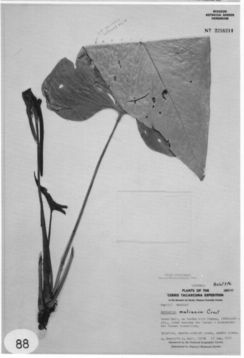




TYPE: Colombia. Choco: Cerro Mali, on Panamanian border 1,200-1,400 m, lower montane wet forest. Gentry & Mori 13818 (MO 2258221, holotype; PMA, isotype).
Planta epiphytica; cataphyllum modice membranaceum, sicce intactum, deciduum, paucamm fibrum persistens; petiolus 11-30 cm longus, sulcatus; lamina modice membranacea leviter bullata, ovato-triangulata ad sub trilobata, basi cordata, usque 32 cm longa, 6.7-22 cm lata; inflorescentia erecta; pedunculus teres, 16-22 cm longus; spatha modice membranacea, viridis ad viridis tincta subrosea, lanceolata, 6-11 cm longa; spadix scssilis, viridis ad luteus, 6-12 cm longus; baccae ignotae.
Epiphyte; stems 5-10 mm diam., internodes short (at least near apex); leaf scars inconspicuous; roots few; cataphylls moderately thin, 11-12.5 cm long, drying intact, faintly reddish brown, the bases of the fibers persisting.
LEAVES with petioles 11-30 cm long, ca. 4 mm diam., sulcate adaxially; geniculum ca. 1 cm long; blades drying greenish, moderately thin, weakly bullate, ovate-triangular to narrowly triangular or sub-3-lobed, narrowly acuminate at apex (the acumen flat), prominently lobed at base, to 32 cm long, 6.7-22 cm wide, broadest at the base; anterior lobe 22-30 cm long, the margins slightly convex to concave; sinus arcuate with a decurrent petiole, broader than deep, ca. 3 cm deep; both surfaces drying conspicuously veiny, matte to semiglossy above, semiglossy below; midrib raised on both surfaces; basal veins 6 or 7 pairs, the uppermost free, the third and higher coalesced 1.5-2.5 cm, the posterior rib weakly curved, naked more than 1 cm; primary lateral veins ca. 15 per side, departing midrib at 40-50¡ angle, weakly arcuate to the collective vein; interprimary and secondary veins drying scarcely less prominent than the primary lateral veins; tertiary and reticulate veins drying prominulous below; collective veins arising from the lowermost basal veins, 1-6 mm from the margin.
INFLORESCENCE erect, shorter than the leaves; peduncle 16-22 cm long, terete; spathe moderately thin, light green to pinkish green, lanceolate, 6-11 cm long, 1.2 cm wide, acuminate at apex, acute at the base, weakly decurrent, inserted at 45¡ angle on peduncle; spadix sessile, yellow to green, gradually tapered, 6-12 cm long, 3.5-5 mm diam. at the base, 2-2.5 mm diam. (dry) near the apex; flowers rhombic to sub-4-lobed, 1.8-2 mm long, about as broad as long, 6-11 flowers visible in the principal spiral; tepals weakly glossy, densely punctate, with raphide cells on drying, the lateral tepals 1-1.4 mm wide, the inner margin broadly rounded, the outer margin with the 2 sides convex; pistil not emergent; stamens weakly emergent, anthers 4-5 mm long, 5-6 mm wide; thecae ovate, moderately divergent.
INFRUCTESCENCE not seen. Fig. 88; not type specimen as photo indicates.
Anthurium malianum is known only from two collections made on Cerro Mali at 1,200 to 1,400 m.
It is distinguished by its moderately thin, veiny, ovate-triangular to sub-three-lobed, bullate blade with numerous primary lateral veins and by the flowers with shield-shaped lateral tepals. It is perhaps best placed in section Polyneurium with relatives of Anthurium argyrostachyum Sodiro but is distinguished by its much smaller leaves. It could probably be confused with A. caperatum, another thin, veiny-bladed species from western Panama and Costa Rica, but the latter diners in having blades typically ovate and usually much larger and in having a more typically cylindroid spadix that is scarcely tapered toward the apex.
Anthurium malianum is also similar to A. niqueanum (from the nearby Serrania de Pirre), but the latter differs in having a thicker blade and in having elongate internodes. Gentry & Mori 13705 differs from the type in having more flowers per spiral (nine to 11 versus five to six on the type).
 |
DARIEN/CHOCO (colombia): Cerro Mali, on border of Panama & Colombia, Gentry & Mori 13705 (MO), 13818 (MO, PMA).